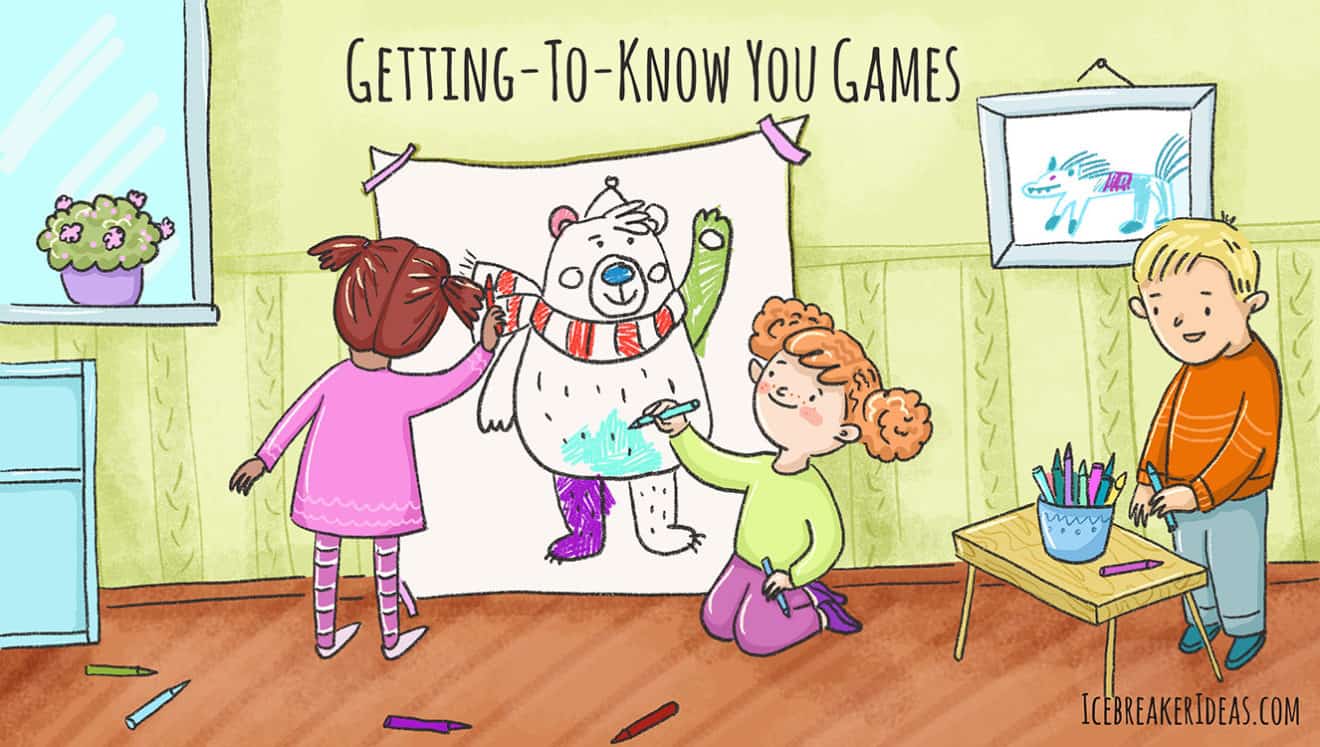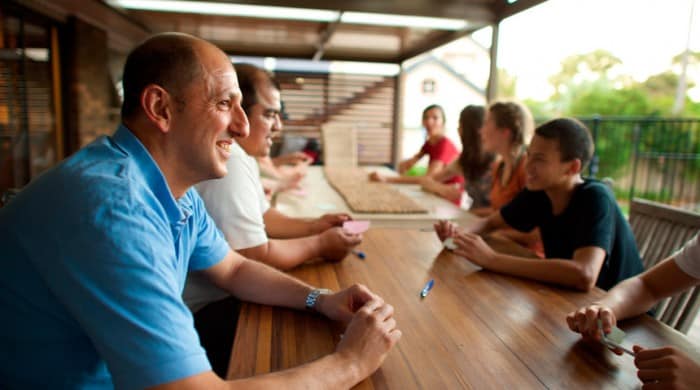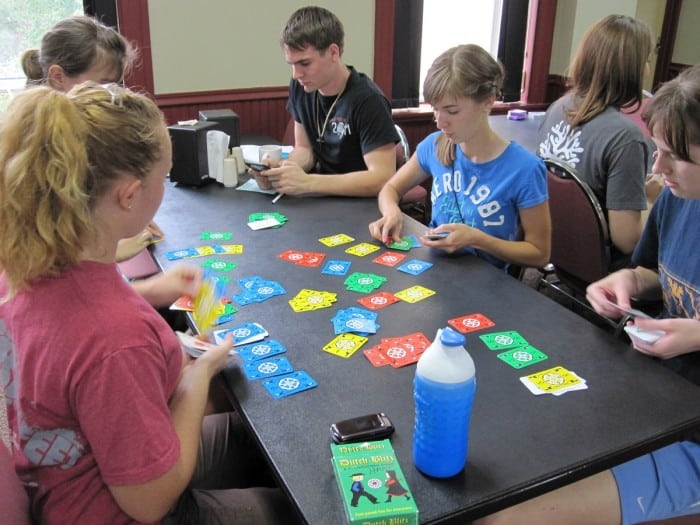Whenever you have a group of people together, they need to get to know each other before participating in the event, activity, or project you have planned. This does not only mean just learning each other’s names, but also involves getting the leader familiar with the group members. Additionally, the group needs to become comfortable working together. Our group of fun get to know you games provides activities to meet all three of these requirements. We have divided our list by ages to make it easy for you to find the perfect activity for any occasion.
Table of Contents
Get to Know You Games for Kids
Kiss the Kids!
For this easy getting-to-know-you activity for kids, you will need some chocolate kisses and a set of age-appropriate questions. Begin with the children seated randomly or in a circle. The leader asks questions and if a student can respond positively, they stand up. You can stop at any time or wait until all the kids are standing. At that point, say, “Everyone needs at least one kiss a day!” and give each participant a candy “kiss.” You can use the following list of questions or make up some of your own:
- If you traveled to another state or country for your last vacation, stand up.
- If you have a brother (sister), sit down. If you are the youngest (oldest) of all the children in your family, stand up.
- If you own a pet, sit down.
- If you have a sister, stand up.
- If your family owns a computer, sit down.
- If you live in an apartment, stand up.
- If you are in ____ grade, stand up.
- If you have blond (brown or black) hair stand up. (You can use this as the last question and use all three colors if you wish to give a chocolate kiss to every child playing.)
Name Tapping
A fun game for learning everyone’s name, this kid’s icebreaker game takes no advance preparation or materials. It is particularly good if you have a few new members joining a group. The children sit in a circle facing each other. Choose one child to be “It” first. This child walks around the outside of the circle tapping the heads of the other children, saying their names. The leader can prompt this child, if necessary. Choose a group name – the name of a flower works well. The second time around the circle, if there is a name the child playing “it” cannot remember, they can say the group name. The child whose name is not remembered becomes “it.” They now walk around the outside of the circle tapping heads and saying names. Continue until all the children appear to know the names of all the group members.
My Bear
A get-to-know-you icebreaker game, you will need a printout of a bear or other animal suitable for coloring and crayons or colored pencils. The goal of this activity is to help each child realize how unique they are and to share with other children in the group. The leader will ask questions and the answer determines which color the children will use to color a particular part of the animal’s body. For younger children, use fewer questions.
Questions
- Do you have any sisters or brothers? If you have a sister, color the animal’s tummy red. If you have a brother, color it blue. If you have both a sister and a brother, color the animal’s tummy purple.
- Do you have any pets? If yes, color the animal’s feet green. If no, color the animal’s feet black.
- What do you like to do most, read a book or draw a picture? If you like to read a book, color the animal’s nose grey. If you like to draw a picture, color the animal’s feet orange.
- Do you like summer or winter best? If you like summer best, color the animal’s fur brown. If you like winter best, leave the animal’s fur white.
When the children are finished, have them look at one another’s animals and spot similarities and differences.
Our Names Book
Although not really a game, we have included this activity because it is such a good getting-to-know-you activity for a group of children. Give each child a thin, long rectangle of colorful paper. Also, provide a supply of crafty materials – crayons, glitter glue, ribbon, buttons, etc. Have the children write their names in big letters on their strip of paper and then decorate it any way they like. After the children finish their creations, have them share what they have designed. Then, when all the glue has dried, staple the pages together inside a colorful cover. This works especially well for a class or group that meets more than once. As new kids join the group, they can add a page to the “book.”
Get to Know You Games for Adults
Cocktail Party
A roll-playing game that is fun, Cocktail Party quickly loosens participants up, relieves social tensions, and helps one learn about themselves and others. This game involves pretending to meet people under different circumstances and acting out how you would talk and act in a given situation. Players should begin by introducing themselves. Suggest some questions participants can use in their conversations such as:
- Hi, how are you?
- What kind of work do you do?
- Where are you from?
- Do you like the food (carpet, curtains, music, etc.)?
- How long are you staying?
Suggested situations are the cocktail party (of course), on the beach, in a nightclub, at the funeral of a mutually loved friend or family member, as competing athletes before tennis match, and as prisoners arriving in jail.
Commonality
An icebreaker game that helps people meet others with whom they have things in common, this game works well for dividing people into teams. Provide a paper and pencil for each player. If you know all of the participants, you can save some time by listing their names on paper beforehand and pass these papers out. Explain that everyone has something in common – at least one thing – with everyone else in the room and their job is to discover commonalities. The players are to mingle and find others with whom they have something in common. It should not be things that are visible, such as hair color or clothing worn. It should be something intangible, such as, “I met a President of the United States.” The winner is the first person to find something in common with all the other players. If you wish to use this game to form teams, set a number of commonalities and when people have found the set number, they form a team.
Seven Word Biographies
A challenging and fun icebreaker game, the goal is for players to write their life story in seven words exactly. Begin by passing out paper and a pen or pencil for each player. Tell players to think carefully and use words that will sum up their life experiences. The stories will end up cryptic and very interesting. The listeners are bound to ask for elaboration and each player has two minutes to answer questions or tell more about their life. You may have such “biographies” as the following:
- Jail time, reformed, married, millionaire, happy!
- Jobless, college graduation, success, married, divorced, France.
Pillow Toss Name Game
As the name implies, you will need a small pillow for this game. The goal of this icebreaker game is for players to learn the names of the group. There are four stages to this game:
- Have the players form a circle. Have one person begin, throwing the pillow to another person as they say their name. The person who catches the pillow says his or her name and quickly throws the pillow to someone else. Keep doing this until everyone has said his or her own name several times.
- Have the players hold the pillow, say someone else’s name, and throw the pillow to that person. Repeat this until each person receives the pillow several times.
- Have players throw the pillow, saying the name of the person and whom they should throw it to next. For example, “Dave, throw the pillow to Susan.” When Dave catches the pillow, he will throw it to Susan, who will name someone else, and who that person needs to toss the pillow to.
- Give players the opportunity to name everyone in the group.
If you wish, you can have players say their names and favorite person, place, or thing to end the game.
Get to Know You Games for Teens
Octopus Tag
A fun and frantic variation of tag, you will need a large area with boundaries set. This game pairs hand-in-hand teens. One pair begins as “It” and runs to catch another pair. Once they catch a pair, they join the first pair. At this point, only the people at the end of the line may tag others. However, if the line breaks, a catch is invalid. Also, if a running pair breaks their hold or runs out of bounds, they are automatically caught. If you have a very large group, you can start with two or more pairs serving as “It” and use this as a team game.
Who Am I?
Give each teen a 3 x 5 card and have them write their name at the top and four things about themselves they are sure no one else in the room knows. Collect the cards and hand out paper and pencils to each player. Give everyone a lined piece of paper and tell the teens to number each line. Read the cards one at a time and have the teens write down to which they believe the card is referring. When you have read all the cards, have the teens exchange papers, and read the correct answers for the teens to check the sheets. Whoever has the most right answers is the winner.
Name and Number Game
Another game using 3 x 5 cards, this icebreaker game will help teens get to know each other and get the group ready for whatever activity or event comes next. When teens first arrive, provide each with an index card. On one side, have them write their name and on the other side, give them a number. Make sure you keep a master list of everyone’s number and name. Have teens mingle, introducing themselves to each other. Make sure you tell them to meet as many other teens as possible. After everyone arrives, give the players a few minutes to mingle. Then have each guest turn their nametag around so only their number is showing. Give each teen a piece of paper with only the numbers on it and have them fill in the names of each person next to their number. The winner is the one who get the most names right.
Find Another Seat
A fun and active game, Find Another Seat takes quick thinking. Have the teens sit on chairs in a circle, with one chair missing. The teen without a chair stands in the middle and tells their name. Then the teen calls out a characteristic, or color or type of clothing. For example, the teen may call out, “Everyone wearing orange!” All the teens who are wearing orange must get up and find another seat, but not one immediately to their right or left. The teen in the middle races to grab a seat and the person left standing becomes the next caller in the middle.
Human Pizza
An icebreaker game that works well for a larger group of teens, you need to prepare ahead of time. Using 3 x 5 cards, write pizza ingredients on each card making sure you have enough for each teen. All the ingredients needed to make one pizza will make up one team. Tape the cards to the teen’s backs, making sure they do not know which ingredient they have. They are to form themselves into groups with each group having all the ingredients and toppings for a pizza. The trick is, they must do so asking only “yes” or “no” questions. The first group to do so is the “winner.” You can use the assembled teams for other games and activities.
Our fun collection of fun get to know you games not only will help you learn the names of the members of a group, but also help them learn each other’s names. Additionally, many of the games help people know something about other group members. Have fun using and sharing this collection of getting-to-know-you icebreaker games.
Get To Know You Activities
Having a few well-planned “get to know you games” will add laughter and fun to any party, the first day of school or camp, or any size group for people of all ages!
A list of supplies is mentioned at the beginning of each game if needed.
Who Is This?
You will need: paper, pencils, blank paper, something like a magazine or file folder, or a table, etc. to give the artists a hard surface to lay their paper to draw; pre-cut slips of paper, and a master list of each person’s name
This game is especially great as a shower game, or the first day of school for children and teens 8 years and older, and adults. It helps to have everyone in a big circle for this activity.
Write a master list with every person’s name, and write each person’s name on a slip of paper. Put the slips of papers with names in a bag or bowl and have each person pick a paper.
Make sure that everyone in the circle has either been introduced or is wearing a name tag. Each person has to draw a picture of the person whose name they drew. Remind the artists to add details (glasses, earrings, jewelry, patterns or pictures on clothes), that might help other people guess who that person is.
- Artists cannot tell anyone who they are drawing. Once a person has finished drawing, the leader takes the picture, quietly finds out the name of the person in the picture, and gives that paper a number. The leader writes the same number by that person’s name on the master list.
- Hand everyone a blank paper and have them number their paper, for example: number to 25, if there are 25 people playing the game. To begin, give each person a picture to guess, and have them write the person’s name on their paper by the number written on the picture. Players will pass their picture to the person next to them on the leader’s signal. Each picture will be passed to each person in the circle.
- When every picture has been seen by every player and the names written on each person’s paper; then it is time for the leader to read the correct numbers and the person that goes with that number. The person(s) who get the most correct win the game.
Acrostic Poem
You will need: paper and a pencil or pen for each person in the group. Something like a magazine, a file folder, or a table, etc. to give the writers a hard surface to lay their paper to write
This activity works extremely well for the first days of school, or at the beginning of the “get to know you” games. It can be used with ages 8 and older.
Each person writes his or her name going down the paper only using capital letters for each letter. Then, he or she writes attributes, strengths, or funny things that begin with that letter. These are written on the line next to the letter that begins those words.
Examples:
Takes 3 point shots and makes them Kind and funny
You know I love cheeseburgers Everyone’s friend
Sisters make me crazy I don’t like cats
Only boy in my family Rainbows are my favorite
Nice to everyone Airplane trip is my goal
The Acrostic poems can be shared in small groups or table groups. Depending on the group size, they can also be shared with the whole group
About Me Shield
You will need: examples of shields for demonstration, paper, pencils, or colored markers; something like a magazine, file folder, or a table, etc. to give the artists a hard surface to lay their paper to draw;
- Hand out a paper and a pencil to each person, or let them share colored markers for this “get to know you” activity. Children ages 4 through adults can successfully complete this activity. For younger children, I would have copied a picture of a shield with the four boxes ready for them to use, with extra copies if needed. Older children and adults are able to draw and divide the shield themselves.
- Each person draws a large shield on a paper, and divides it into 4 parts. In the first box, have each of them draw or write something they like to do (a hobby). Next, in the second box, each person can draw or write something(s) they love. In the third box, everyone will draw or write a place they like to go, or would like to visit. And, in the fourth box, each person will write or draw a picture of their favorite movie, or TV show.
- There are several ways to share each person’s shield, depending on the size of the group and the ages of the people: partner sharing, small group or table sharing, or whole group if it is possible, for each person to share their shield information with the entire group.
It’s What I Like About You
You will need: cardstock-heavy paper sheets with the title, “It’s What I Like About You,” at the top, and a blank for the person’s name ; 2 holes, one on each side, punched at the top of the paper; and a long piece of string or yarn to tie at each punched hole, and go around a person’s neck and hang down their back; and a pen or pencil
This is a wonderful way to end a “get to know you” group experience when everyone is comfortable and familiar with each other. It works best for ages 8 and above. I have done this activity with older children, teenagers, and adults, and it works beautifully with every group.
Each person gets a paper with the string or yarn attached ready to begin. Have every person in the group write his or her name on the blank of their paper, and put the paper so it hangs down their back with the string around their neck.
Tell the group that they are going to move around the area and write strengths, funny or nice things on as many papers as they would like; while letting everyone who wants to, write strengths or nice things on their paper do so. Make sure that each person understands that only kind, positive things can be written on the papers. They cannot write mean or rude comments. Help each person to understand that the object of this “get to know you” activity is to help each person feel good about themselves.
The person writing can sign their name, or leave their message unsigned. If your group is young, brainstorm examples of kind and nice things to write; so that it might be a self-esteem building experience for everyone. It may help younger children to have their brainstorm ideas written down for the group to see and use for ideas. I have done this activity three times myself, and each paper is a treasure of my strengths and good things that others see in me.
Inside, Outside Circle
You will need: questions prepared ahead of time to ask your group as they share with each other.
Examples:
- Where is a place that you would love to go? Why?
- Would you rather sail across the ocean, or fly in an airplane? Why?
- If you could, would you rather live in the old west, or in the future? Why?
- Who is a person living now, that you would like to meet? Why?
- Would you rather go to a movie, or stay home and watch TV? Why?
- What would you do if you won a million dollars?
- What is something you like about yourself?
- If you could be any animal, what would it be? Why?
This “get to know you game” takes a few minutes to move people to the inside circle facing out, or around the outside circle facing in, but it is worth it! Pair up each person in the inside circle with a person on the outside circle. If there is an odd number of people, one of the leaders can be the partner needed.
Ask the inside people to tell their partners the answer to the question. Outside partners only listen to their partner now. Then, ask the outside circle to move two people to the right, and to tell their answer of the same question, to the new inside partner who is just listening. Give each group about 30 seconds to one minute to tell their answer to the question.
Keep the circles moving so that each person gets to listen and to share ideas with different people. Move three to the left, answer a question; move one to the right, answer a question. etc. The challenge for the leader calling directions and moves, is to not pair people together that have already been partners.
Be aware to end the game before players lose interest or run out of new people to have as a partner.
Name and Action
Children, teens, and adults enjoy this game because it gives each person a chance to be noticed and remembered. If your group is more than 12 – 15 people, divide the people into two groups.
Let your group(s) know that they will say their name, and demonstrate some type of an action that the group can do. Start with a leader who can demonstrate what to do.
Example: “My name is Michael,” (action) swings a pretend baseball bat. The next person does player one’s name and action, “Michael,” (action) swings a pretend baseball bat. Then, adds his or her own name and action, “I’m Nichole,” (action) does a dance move. The third person begins with player one and two’s names and actions “Michael,” swings a baseball bat. “Nichole,” does the dance move. Then says his or her own name and does the action, “My name is Brittany,” (action) sings in an opera-like voice, etc.
Remembering and telling each player’s name and action continue around the circle until everyone has had a turn The last person will tell the name and do the action of every person in the circle beginning with the first person, and ending with their name and action.
Susan majored in English with a double minor in Humanities and Business at Arizona State University and earned a Master’s degree in Educational Administration from Liberty University. She taught grades four through twelve in both public and private schools. Subjects included English, U.S. and world history and geography, math, earth and physical science, Bible, information technologies, and creative writing.
Susan has been freelance writing for over ten years, during which time she has written and edited books, newspaper articles, biographies, book reviews, guidelines, neighborhood descriptions for realtors, Power Point presentations, resumes, and numerous other projects.




